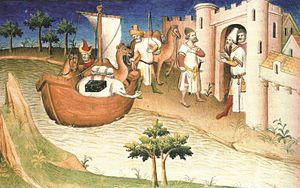Western imperialism in Asia as presented in this article pertains to Western European entry into what was first called called the East Indies. This was sparked early in the 15th century by the search for trade routes to China that led directly to the Age of Discovery, and the introduction of early modern warfare into what was then called the Far East. By the early 16th century the Age of Sail greatly expanded Western European influence and development of the Spice Trade under colonialism. There has been a presence of Western European colonial empires and imperialism in Asia throughout six centuries of colonialism, formally ending with the independence of the Portuguese Empire's last colony East Timor in 2002. The empires introduced Western concepts of nation and the multinational state. This article attempts to outline consequently development of the Western concept of the nation state. The thrust of European political power, commerce, and culture in Asia gave rise to growing trade in commodities—a key development in the rise of today's modern world free market economy.In the 16th century, the Portuguese broke the (overland) monopoly of the Arabs and Italians of trade between Asia and Europe by the discovery of the sea route to India around the Cape of Good Hope. With the ensuing rise of the rival Dutch East India Company, Portuguese influence in Asia was gradually eclipsed. Dutch forces first established independent bases in the East (most significantly Batavia, the heavily fortified headquarters of the Dutch East India Company) and then between 1640 and 1660 wrestled Malacca, Ceylon, some southern Indian ports, and the lucrative Japan trade from the Portuguese. Later, the English and the French established settlements in India and established a trade with China and their own acquisitions would gradually surpass those of the Dutch. Following the end of the Seven Years' War in 1763, the British eliminated French influence in India and established the British East India Company as the most important political force on the Indian Subcontinent.Before the Industrial Revolution in the mid-to-late 19th century, demand for oriental goods such as (porcelain, silk, spices and tea) remained the driving force behind European imperialism, and (with the important exception of British East India Company rule in India) the European stake in Asia remained confined largely to trading stations and strategic outposts necessary to protect trade. Industrialisation, however, dramatically increased European demand for Asian raw materials; and the severe Long Depression of the 1870s provoked a scramble for new markets for European industrial products and financial services in Africa, the Americas, Eastern Europe, and especially in Asia. This scramble coincided with a new era in global colonial expansion known as "the New Imperialism," which saw a shift in focus from trade and indirect rule to formal colonial control of vast overseas territories ruled as political extensions of their mother countries. Between the 1870s and the beginning of World War I in 1914, the United Kingdom, France, and the Netherlands — the established colonial powers in Asia — added to their empires vast expanses of territory in the Middle East, the Indian Subcontinent, and South East Asia. In the same period, the Empire of Japan, following the Meiji Restoration; the German Empire, following the end of the Franco-Prussian War in 1871; Tsarist Russia; and the United States, following the Spanish-American War in 1898, quickly emerged as new imperial powers in East Asia and in the Pacific Ocean area.In Asia, World War I and World War II were played out as struggles among several key imperial powers—conflicts involving the European powers along with Russia and the rising American and Japanese powers. None of the colonial powers, however, possessed the resources to withstand the strains of both world wars and maintain their direct rule in Asia. Although nationalist movements throughout the colonial world led to the political independence of nearly all of the Asia's remaining colonies, decolonisation was intercepted by the Cold War; and South East Asia, South Asia, the Middle East, and East Asia remained embedded in a world economic, financial, and military system in which the great powers compete to extend their influence. However, the rapid post-war economic development of the East Asian Tigers, India, the People's Republic of China, along with the collapse of the Soviet Union, have loosened European and North American influence in Asia, generating speculation today about emergence of modern India and China as potential superpowers.




Aipatu
0